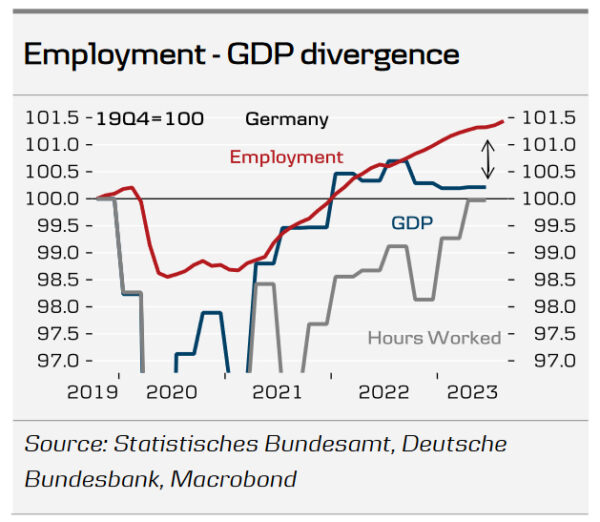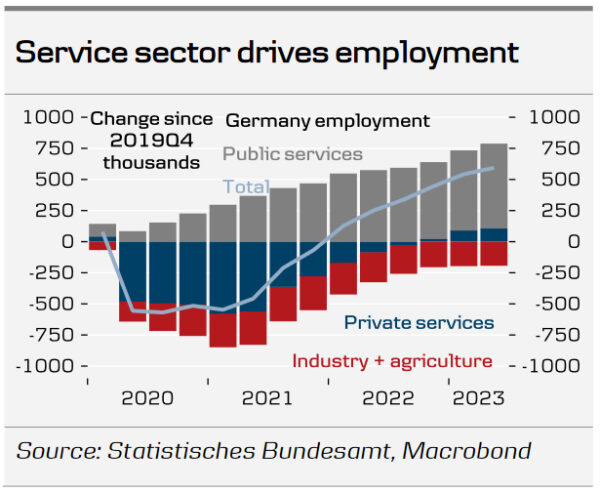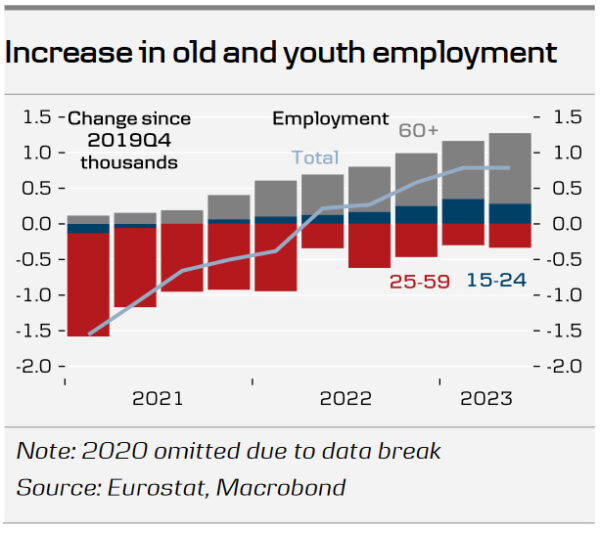- The German labour market has remained remarkably strong despite weak economic activity overall. While GDP has fallen since 2022Q3 employment has increased continuously.
- We find that the major drivers behind strong employment growth in Germany is strong public sector employment growth and part-time employment.
- Also demographics, and a larger share of service sector employment drive the divergence between employment and GDP.
On the surface the German labour market has defied gravity by recording continuous increases in employment during the last year despite the slump in economic activity. Employment has increased with around 1.5% since 2019Q4 while GDP is broadly unchanged. However, beneath the surface we find that total hours worked has increased less than the number of employed persons since the share of part-time workers increased from 27.9% in 2019Q4 to 30.2% in 2023Q2. This reduction in average working time is one driver of the recent divergence between employment and GDP.
The reduction in average time worked per employee also happened during the global financial crisis as German companies have the option to reduce working time for employees instead of laying them off due to the so-called ‘kurzarbeit’ schemes.
The rise in (public) service sector employment also explains why employment has been so strong compared to GDP. Employment in the public sector has increased each quarter since 2019Q4 except for one, and accounts for 115% of total employment growth. Private employment in the industry is still below pre-pandemic levels. The German industry has been in contraction since 2022Q3 and since then the private service sector has accounted for 80% of the employment increase in the private sector. Productivity is lower in both the public and private service sector compared to the industry as the industry has more capital per worker.
The recent labour market demographics is another explanation of the relatively strong aggregate employment figures. The German labour force is ageing and the number of employees above 60 years has increased with one million since 2019Q4. An ageing work force can affect productivity both positively and negatively but the majority of the effects are negative (see IMF – The Impact of Workforce Aging on European Productivity). Moreover, the share of part-time employment is larger for both old (23.3%) and young (25.7%) employees compared to prime working age employees (19.4%).
Taking stock of the current situation in the German economy high frequency indicators suggest that employment continued to increase in 2023Q3 driven by the service sector while GDP declined further. In the coming quarters, we expect employment to start declining as the monetary policy tightening works its’ way through the economy to the labour market and economic activity becomes so weak that companies stop hoarding labour. Yet, we still foresee a tight labour market with the unemployment rate only marginally higher in 2024 as companies utilise the ‘kurzarbeit’ employment schemes.

















